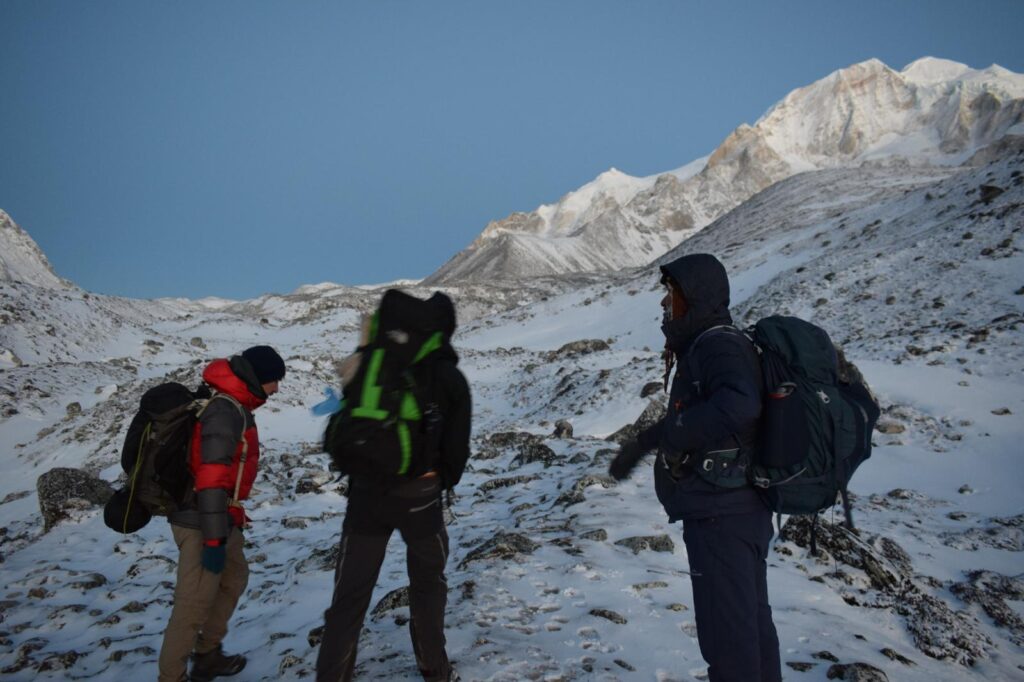Nepal is well-known for its stunning mountains and incredible trekking trails. These trails attract adventurers from all over the world.
However, not all treks are the same—some are easy and suitable for beginners, while others are more difficult and require experience and preparation.
If you’re planning a trek in Nepal, it’s important to know the different levels of difficulty so you can pick the trek that matches your fitness and experience.
This guide will make it simple for you to understand these difficulty levels and help you make the best choice.
Factors that Affect Trekking Difficulty
Before we talk about specific treks, let’s look at the main factors that affect trekking difficulty in Nepal:
Altitude
The higher you go, the thinner the air becomes. At high altitudes, there is less oxygen, which can make it hard to breathe. Treks that reach high altitudes are usually more difficult.
Distance and Duration
Longer treks that take many days are generally more difficult, especially if you need to walk for 6 to 8 hours a day.
Trail Conditions
Some trails are steep, rocky, or uneven. Treks with difficult terrain can be harder, especially for beginners.
Weather
The weather in the mountains can change quickly. Cold temperatures, rain, or snow can make trekking more challenging.
Fitness Level
Your physical fitness is an important factor. If you are fit and used to walking long distances, you will find trekking easier.
Easy Treks in Nepal
Easy treks are great for beginners or families. These treks do not go too high, and the trails are less challenging. You do not need to be super fit to enjoy these treks, but being comfortable with walking for a few hours a day is helpful.
1. Ghorepani Poon Hill Trek
The Ghorepani Poon Hill Trek is one of the most popular easy treks in Nepal. It takes about 4 to 5 days and offers beautiful views of the Annapurna and Dhaulagiri mountain ranges. The highest point is Poon Hill (3,210 meters), where you can enjoy a stunning sunrise over the mountains.
- Difficulty Level: Easy
- Best Time: Spring (March to May) and Autumn (September to November)
The trails are well-marked, and you will pass through beautiful rhododendron forests and traditional villages. It is a perfect trek if you want to experience the beauty of the Himalayas without too much physical challenge.
2. Langtang Valley Trek
The Langtang Valley Trek is another easy to moderate trek that takes about 7 to 9 days. It is a great option if you want to explore beautiful landscapes and experience the culture of the Tamang people.
- Difficulty Level: Easy to Moderate
- Best Time: Spring and Autumn
The highest point of this trek is Kyanjin Ri (4,773 meters), but you can choose whether or not to climb it. The trek takes you through forests, rivers, and small villages, and you can see amazing views of Langtang Lirung and other peaks.
Moderate Treks in Nepal
Moderate treks are a bit more challenging than easy treks. They may go to higher altitudes, have longer walking days, or involve steeper trails. These treks are great if you are reasonably fit and want a bit of adventure.
1. Annapurna Base Camp (ABC) Trek
The Annapurna Base Camp Trek is one of the most popular treks in Nepal. It takes about 7 to 12 days and takes you to the base camp of Annapurna I, one of the highest mountains in the world.
- Difficulty Level: Moderate
- Best Time: Spring and Autumn
The highest point is Annapurna Base Camp (4,130 meters). The trail is a mix of stone steps, forests, and mountain views. You will pass through beautiful villages like Chhomrong and Bamboo, and the views of Machapuchare (Fishtail Mountain) are stunning.
2. Manaslu Circuit Trek
The Manaslu Trek is a beautiful trek that goes around Mount Manaslu, the eighth-highest mountain in the world. It takes about 14 to 18 days to complete and is becoming more popular among trekkers who want a quieter experience compared to the Annapurna Circuit.
- Difficulty Level: Moderate to Challenging
- Best Time: Spring and Autumn
The highest point of the Manaslu trek is the Larkya La Pass (5,106 meters). This trek takes you through remote villages, dense forests, and high mountain passes. It is a great choice if you want to experience beautiful scenery and traditional culture without the crowds.
Challenging Treks in Nepal
Challenging treks are for experienced trekkers who are physically fit and ready for an adventure. These treks go to high altitudes, have long walking days, and sometimes involve steep and difficult trails.
1. Everest Base Camp (EBC) Trek
The Everest Base Camp Trek is one of the most famous treks in the world. It takes about 12 to 14 days and takes you to the base camp of Mount Everest, the highest mountain in the world.
- Difficulty Level: Challenging
- Best Time: Spring and Autumn
The highest point is Kala Patthar (5,545 meters), which offers amazing views of Everest. The trail takes you through famous places like Namche Bazaar and Tengboche Monastery. The altitude and long days make this trek challenging, but the views and sense of achievement are worth it.
2. Three Passes Trek
The Three Passes Trek is one of the most challenging treks in the Everest region. It takes about 18 to 21 days and takes you over three high mountain passes: Kongma La (5,535 meters), Cho La (5,420 meters), and Renjo La (5,360 meters).
- Difficulty Level: Very Challenging
- Best Time: Spring and Autumn
This trek offers some of the best views of the Khumbu region, including Mount Everest, Lhotse, Ama Dablam, and many others. The trek is physically demanding, but it is a great adventure for experienced trekkers who want a challenge.
How to Choose the Right Trek for You
Choosing the right trek depends on your experience, fitness level, and what kind of adventure you want. Here are some tips to help you decide:
Know Your Fitness Level
Be honest about your physical fitness. If you are new to trekking, start with an easy or moderate trek like Ghorepani Poon Hill or Langtang Valley.
Consider the Duration
Some treks are shorter and can be done in less than a week, while others take two to three weeks. Choose a trek that fits your schedule and stamina.
Altitude Matters
High altitudes can be challenging, especially if you are not used to them. If you are worried about altitude sickness, choose a trek that does not go too high, like Annapurna Base Camp.
Think About the Experience
Do you want to see famous mountains like Everest or explore quieter trails? Treks like the Manaslu Circuit offer a more peaceful experience compared to popular treks like Everest Base Camp.
Hire a Guide
For more challenging treks, hiring a guide is a good idea. A guide can help you navigate the trail, manage altitude sickness, and learn about the local culture.
Tips for Trekking in Nepal
- Train Before Your Trek: If you are planning a moderate or challenging trek, train beforehand. Walking, hiking, and cardio exercises will help you get fit.
- Pack Light: Carry only what you need. A heavy backpack can make trekking much harder. Pack clothes you can layer, and bring essentials like a good sleeping bag and trekking poles.
- Acclimatize Properly: For high-altitude treks, take your time to acclimatize. Rest days are important to let your body adjust to the altitude.
- Stay Hydrated: Drink plenty of water, especially at high altitudes where dehydration can make altitude sickness worse.
- Respect the Culture: Nepal has a rich culture, and the local people are very welcoming. Respect local customs, dress modestly, and always ask before taking photos of people.
Nepal is a paradise for trekkers, offering a range of trekking options suitable for every type of adventurer. Whether you’re a first-time trekker or a seasoned mountaineer, Nepal has something for everyone.
The beauty of the landscape, combined with the rich cultural experiences, makes trekking in Nepal an unforgettable journey. Choosing the right trek based on your fitness level and experience will ensure you get the most out of your adventure.
For those looking for a gentle introduction to trekking, the Ghorepani Poon Hill Trek is a perfect choice. This relatively easy trek takes you through charming villages, lush forests, and terraced fields, with stunning panoramic views of the Annapurna and Dhaulagiri mountain ranges.
With moderate elevation gain and no technical climbing, it’s an ideal trek for beginners or those looking for a relaxed walk with beautiful scenery. The trek also offers a chance to experience the culture of the Gurung and Magar communities, making it both a scenic and culturally enriching experience.
If you’re looking for something a bit more challenging, the Manaslu Circuit Trek offers the perfect balance of adventure and reward. Known for its dramatic landscapes and remote villages, this trek takes you around the Manaslu Massif, the eighth-highest mountain in the world.
Along the way, you’ll encounter Buddhist monasteries, remote settlements, and impressive views of snow-capped peaks, including Manaslu, Himlung Himal, and Ganesh Himal. The Manaslu Circuit also offers a unique opportunity to explore a less crowded route, providing a more tranquil and authentic trekking experience.
For experienced trekkers seeking a real challenge, the Everest Base Camp Trek is an iconic journey that brings you into the heart of the Himalayas. This trek is known for its demanding nature, with rugged terrain, high-altitude conditions, and steep ascents.
As you make your way to Everest Base Camp, you’ll pass through Sherpa villages, visit ancient monasteries, and enjoy stunning views of the world’s tallest mountain. The trek requires a good level of fitness and stamina, as well as proper acclimatization, especially due to the high altitudes you’ll reach.
Happy trekking, and remember that no matter the difficulty level, you’re sure to have an unforgettable adventure in the majestic mountains of Nepal!






